International Business: Make My Shoe Australia Market Entry Report
VerifiedAdded on 2020/03/07
|21
|3531
|71
Report
AI Summary
This report evaluates the feasibility of Make My Shoe entering the Australian market, analyzing various aspects. It examines economic factors such as GDP, inflation, and per capita income, highlighting the impact of government policies on foreign direct investment. Political stability and the legal framework, including business regulations and trade agreements, are assessed. The report also delves into the trade and investment environment, including FDI trends, major trading partners, and foreign exchange issues. Financial factors and cultural considerations are also discussed. The report provides recommendations based on these factors, concluding that entering the Australian market presents a significant opportunity for Make My Shoe, considering the country's developed economy and favorable business environment. The report uses secondary data from government sources to provide an overview of the Australian market and its potential.
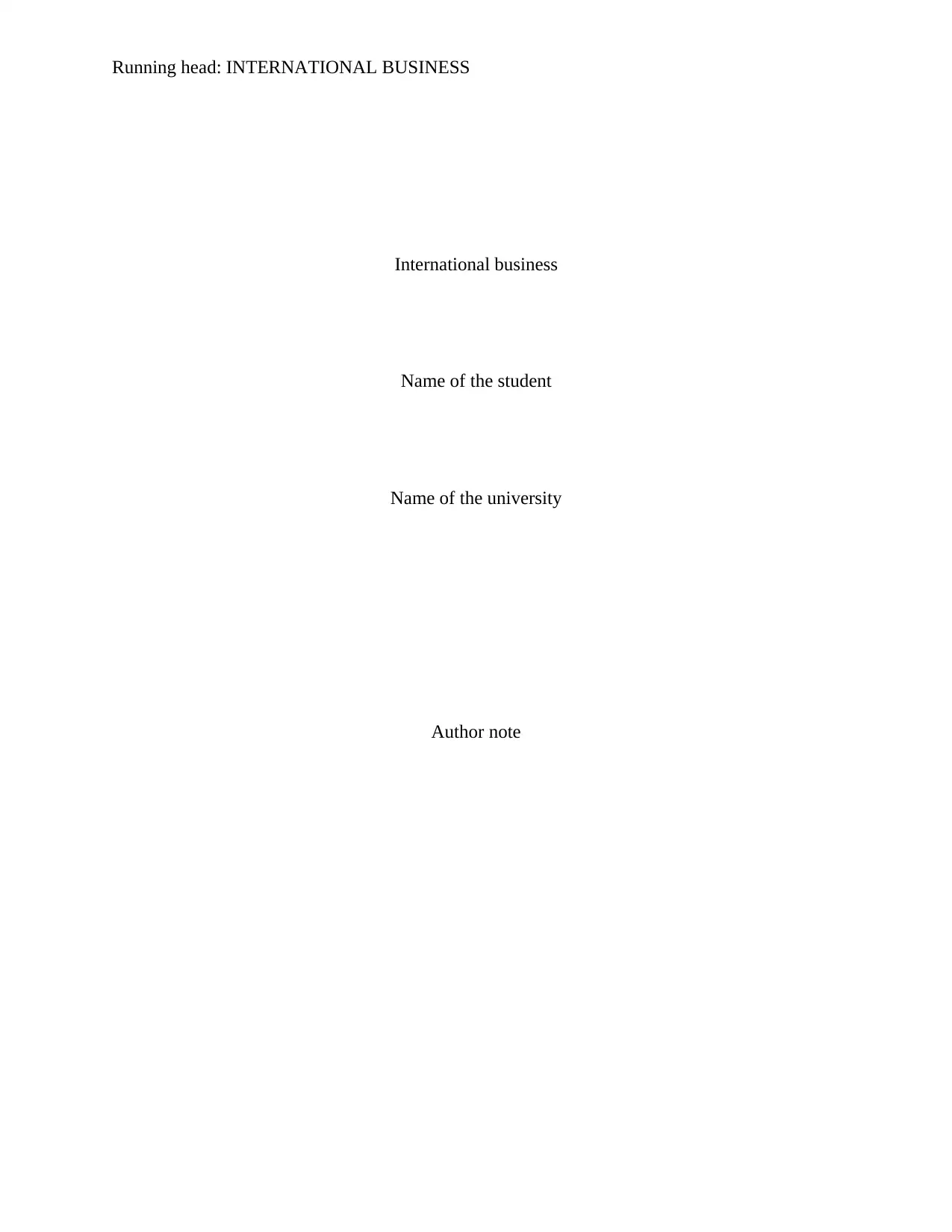
Running head: INTERNATIONAL BUSINESS
International business
Name of the student
Name of the university
Author note
International business
Name of the student
Name of the university
Author note
Secure Best Marks with AI Grader
Need help grading? Try our AI Grader for instant feedback on your assignments.
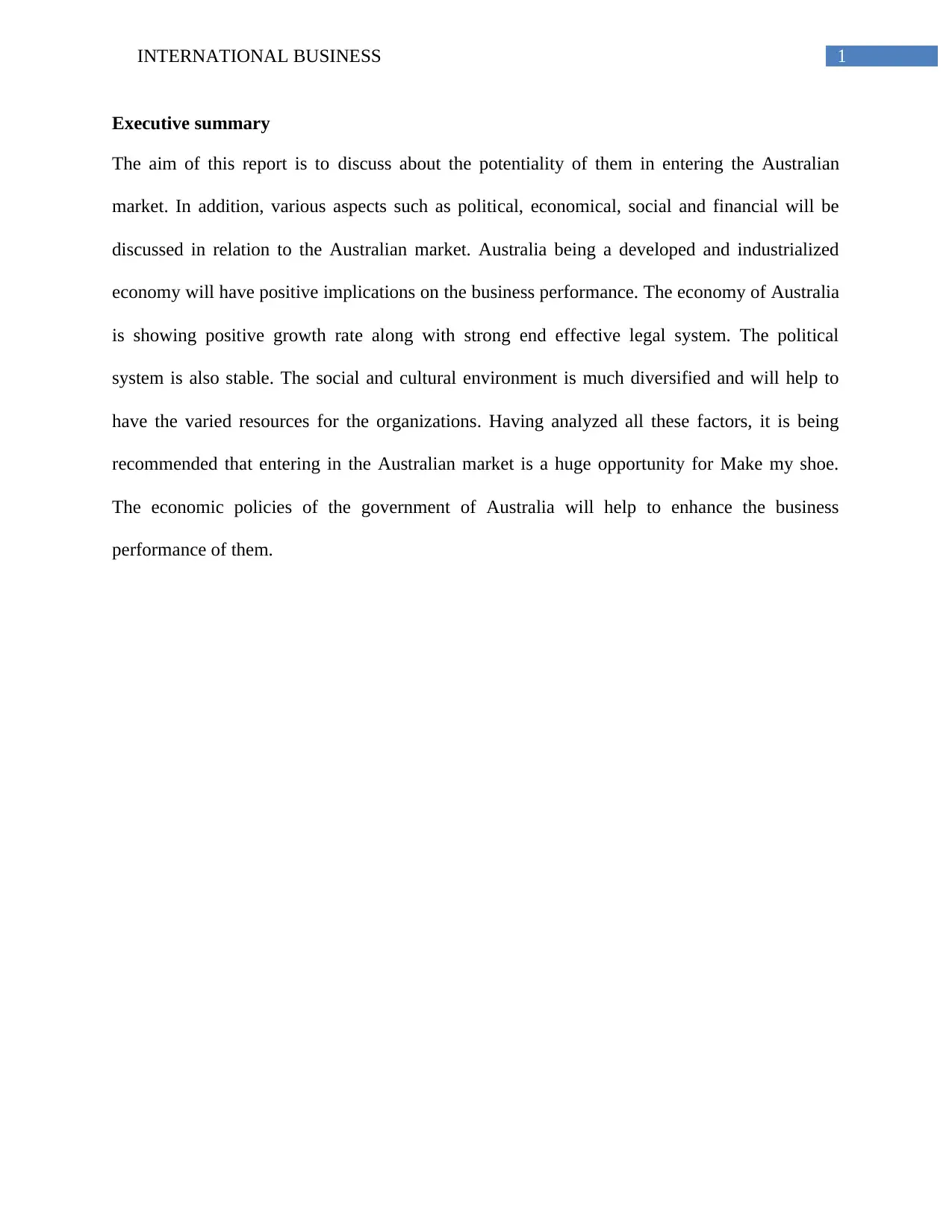
1INTERNATIONAL BUSINESS
Executive summary
The aim of this report is to discuss about the potentiality of them in entering the Australian
market. In addition, various aspects such as political, economical, social and financial will be
discussed in relation to the Australian market. Australia being a developed and industrialized
economy will have positive implications on the business performance. The economy of Australia
is showing positive growth rate along with strong end effective legal system. The political
system is also stable. The social and cultural environment is much diversified and will help to
have the varied resources for the organizations. Having analyzed all these factors, it is being
recommended that entering in the Australian market is a huge opportunity for Make my shoe.
The economic policies of the government of Australia will help to enhance the business
performance of them.
Executive summary
The aim of this report is to discuss about the potentiality of them in entering the Australian
market. In addition, various aspects such as political, economical, social and financial will be
discussed in relation to the Australian market. Australia being a developed and industrialized
economy will have positive implications on the business performance. The economy of Australia
is showing positive growth rate along with strong end effective legal system. The political
system is also stable. The social and cultural environment is much diversified and will help to
have the varied resources for the organizations. Having analyzed all these factors, it is being
recommended that entering in the Australian market is a huge opportunity for Make my shoe.
The economic policies of the government of Australia will help to enhance the business
performance of them.
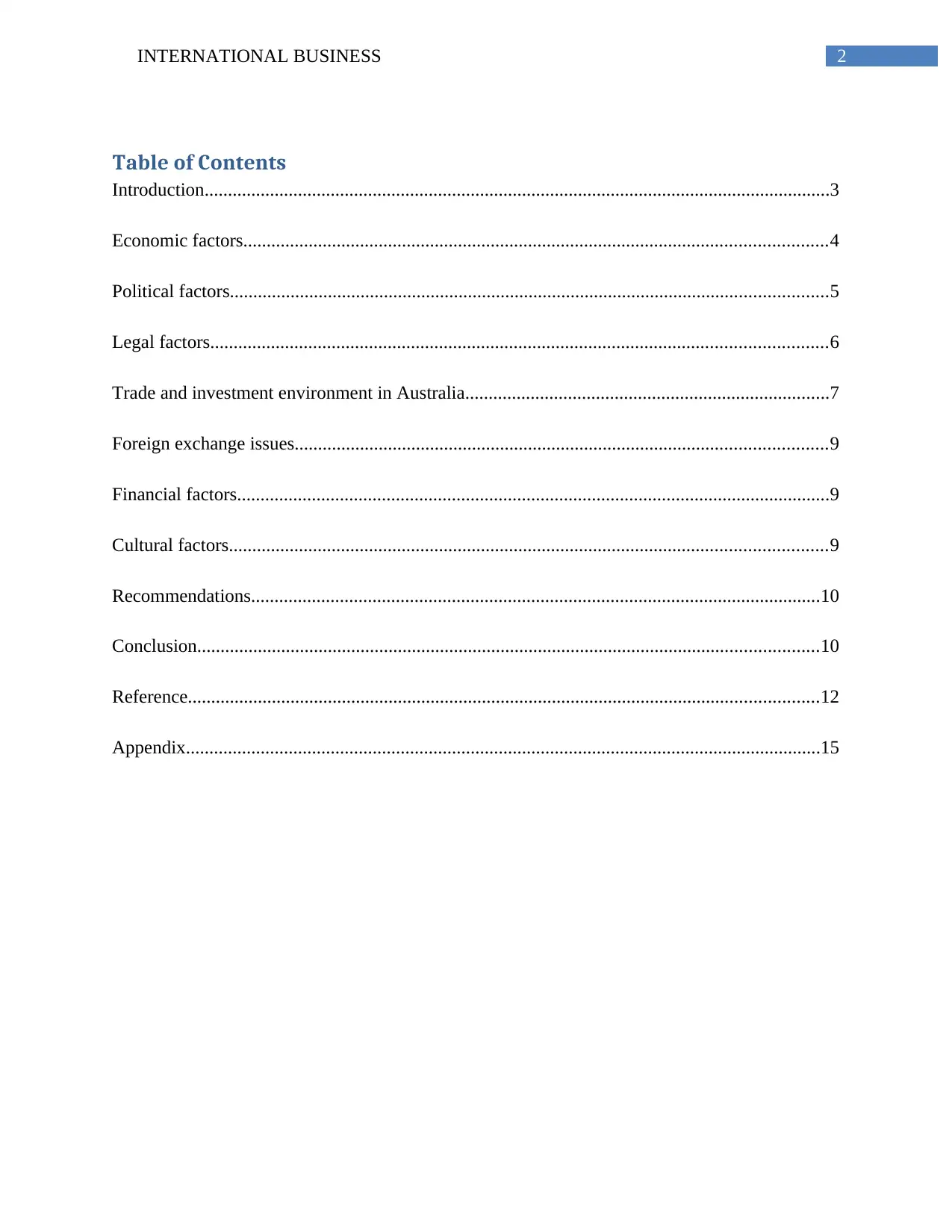
2INTERNATIONAL BUSINESS
Table of Contents
Introduction......................................................................................................................................3
Economic factors.............................................................................................................................4
Political factors................................................................................................................................5
Legal factors....................................................................................................................................6
Trade and investment environment in Australia..............................................................................7
Foreign exchange issues..................................................................................................................9
Financial factors...............................................................................................................................9
Cultural factors................................................................................................................................9
Recommendations..........................................................................................................................10
Conclusion.....................................................................................................................................10
Reference.......................................................................................................................................12
Appendix........................................................................................................................................15
Table of Contents
Introduction......................................................................................................................................3
Economic factors.............................................................................................................................4
Political factors................................................................................................................................5
Legal factors....................................................................................................................................6
Trade and investment environment in Australia..............................................................................7
Foreign exchange issues..................................................................................................................9
Financial factors...............................................................................................................................9
Cultural factors................................................................................................................................9
Recommendations..........................................................................................................................10
Conclusion.....................................................................................................................................10
Reference.......................................................................................................................................12
Appendix........................................................................................................................................15
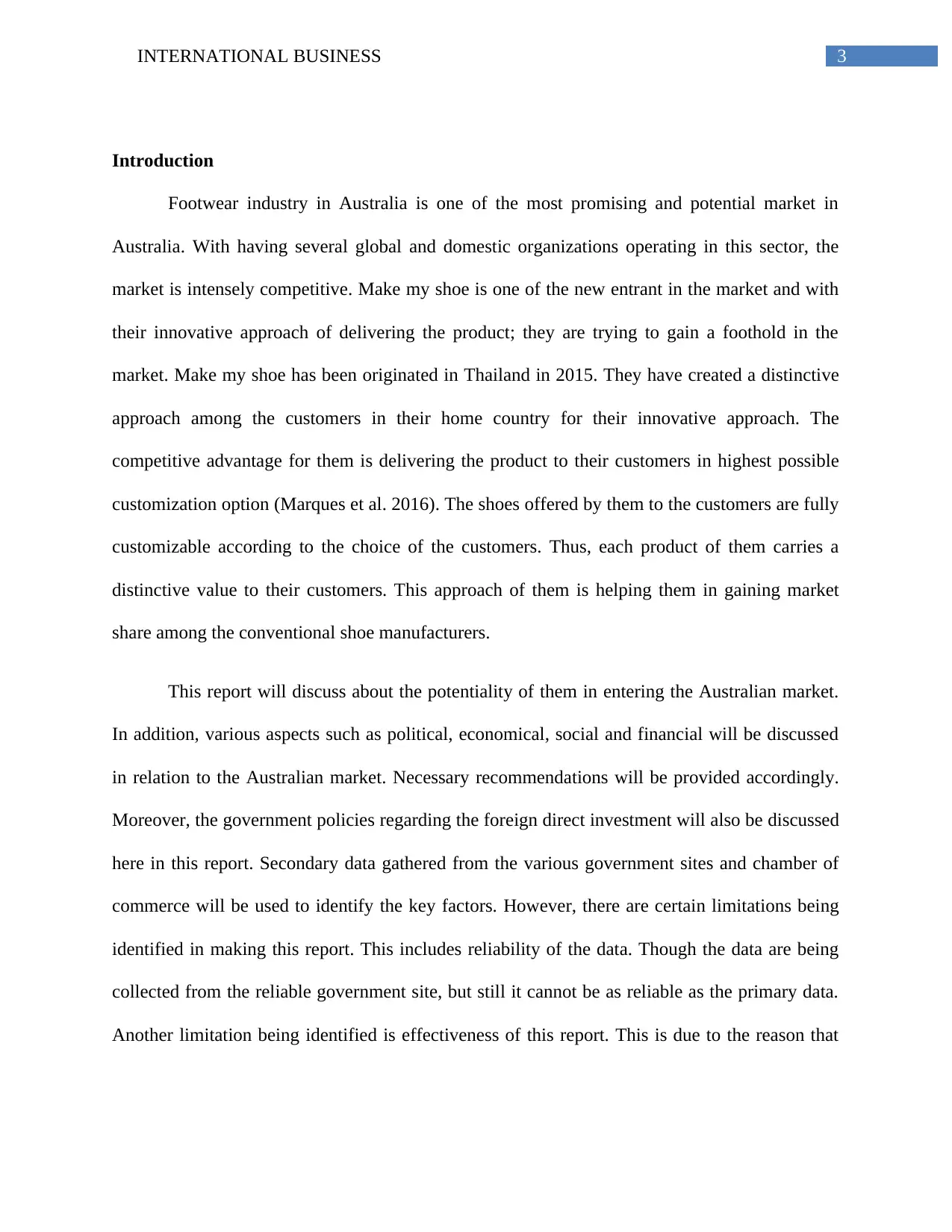
3INTERNATIONAL BUSINESS
Introduction
Footwear industry in Australia is one of the most promising and potential market in
Australia. With having several global and domestic organizations operating in this sector, the
market is intensely competitive. Make my shoe is one of the new entrant in the market and with
their innovative approach of delivering the product; they are trying to gain a foothold in the
market. Make my shoe has been originated in Thailand in 2015. They have created a distinctive
approach among the customers in their home country for their innovative approach. The
competitive advantage for them is delivering the product to their customers in highest possible
customization option (Marques et al. 2016). The shoes offered by them to the customers are fully
customizable according to the choice of the customers. Thus, each product of them carries a
distinctive value to their customers. This approach of them is helping them in gaining market
share among the conventional shoe manufacturers.
This report will discuss about the potentiality of them in entering the Australian market.
In addition, various aspects such as political, economical, social and financial will be discussed
in relation to the Australian market. Necessary recommendations will be provided accordingly.
Moreover, the government policies regarding the foreign direct investment will also be discussed
here in this report. Secondary data gathered from the various government sites and chamber of
commerce will be used to identify the key factors. However, there are certain limitations being
identified in making this report. This includes reliability of the data. Though the data are being
collected from the reliable government site, but still it cannot be as reliable as the primary data.
Another limitation being identified is effectiveness of this report. This is due to the reason that
Introduction
Footwear industry in Australia is one of the most promising and potential market in
Australia. With having several global and domestic organizations operating in this sector, the
market is intensely competitive. Make my shoe is one of the new entrant in the market and with
their innovative approach of delivering the product; they are trying to gain a foothold in the
market. Make my shoe has been originated in Thailand in 2015. They have created a distinctive
approach among the customers in their home country for their innovative approach. The
competitive advantage for them is delivering the product to their customers in highest possible
customization option (Marques et al. 2016). The shoes offered by them to the customers are fully
customizable according to the choice of the customers. Thus, each product of them carries a
distinctive value to their customers. This approach of them is helping them in gaining market
share among the conventional shoe manufacturers.
This report will discuss about the potentiality of them in entering the Australian market.
In addition, various aspects such as political, economical, social and financial will be discussed
in relation to the Australian market. Necessary recommendations will be provided accordingly.
Moreover, the government policies regarding the foreign direct investment will also be discussed
here in this report. Secondary data gathered from the various government sites and chamber of
commerce will be used to identify the key factors. However, there are certain limitations being
identified in making this report. This includes reliability of the data. Though the data are being
collected from the reliable government site, but still it cannot be as reliable as the primary data.
Another limitation being identified is effectiveness of this report. This is due to the reason that
Secure Best Marks with AI Grader
Need help grading? Try our AI Grader for instant feedback on your assignments.
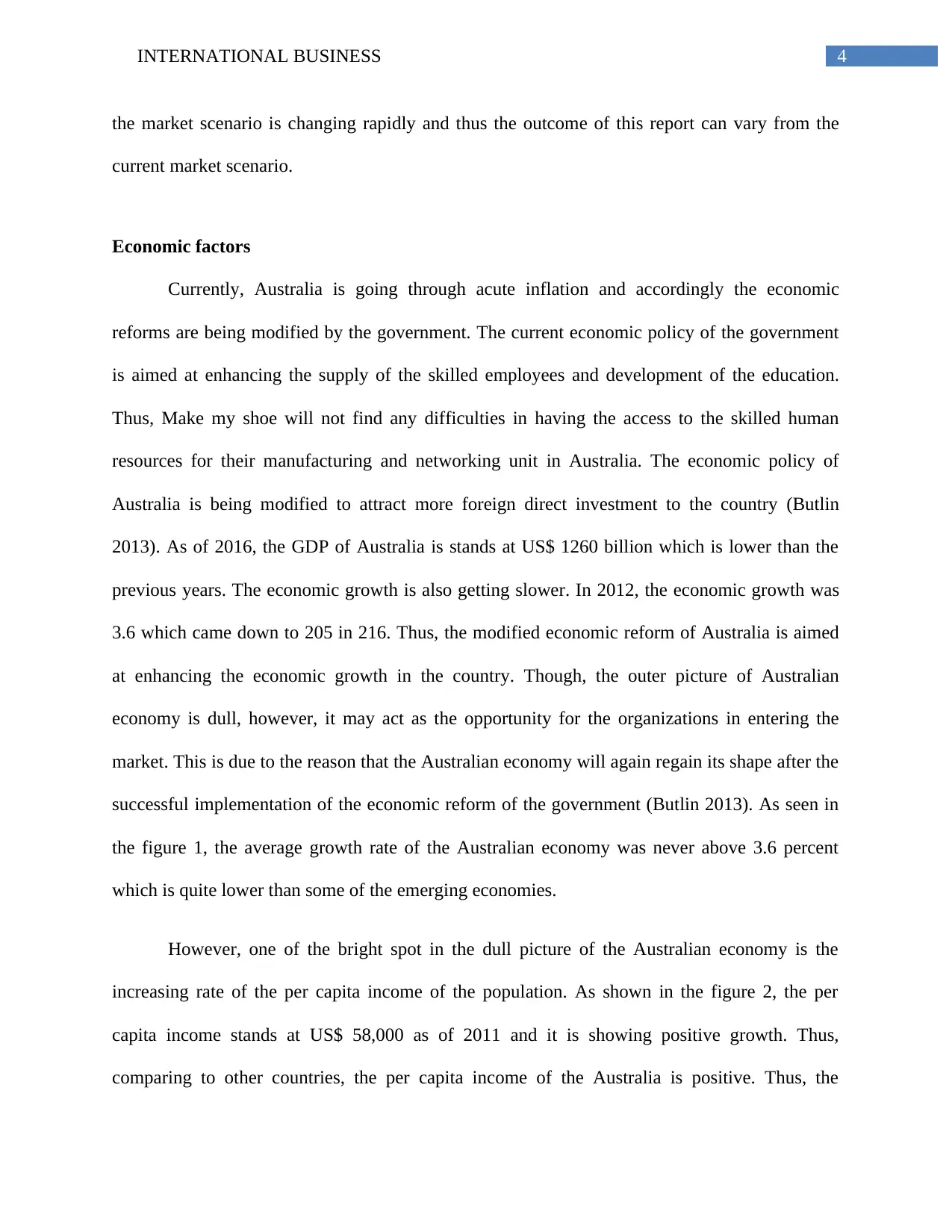
4INTERNATIONAL BUSINESS
the market scenario is changing rapidly and thus the outcome of this report can vary from the
current market scenario.
Economic factors
Currently, Australia is going through acute inflation and accordingly the economic
reforms are being modified by the government. The current economic policy of the government
is aimed at enhancing the supply of the skilled employees and development of the education.
Thus, Make my shoe will not find any difficulties in having the access to the skilled human
resources for their manufacturing and networking unit in Australia. The economic policy of
Australia is being modified to attract more foreign direct investment to the country (Butlin
2013). As of 2016, the GDP of Australia is stands at US$ 1260 billion which is lower than the
previous years. The economic growth is also getting slower. In 2012, the economic growth was
3.6 which came down to 205 in 216. Thus, the modified economic reform of Australia is aimed
at enhancing the economic growth in the country. Though, the outer picture of Australian
economy is dull, however, it may act as the opportunity for the organizations in entering the
market. This is due to the reason that the Australian economy will again regain its shape after the
successful implementation of the economic reform of the government (Butlin 2013). As seen in
the figure 1, the average growth rate of the Australian economy was never above 3.6 percent
which is quite lower than some of the emerging economies.
However, one of the bright spot in the dull picture of the Australian economy is the
increasing rate of the per capita income of the population. As shown in the figure 2, the per
capita income stands at US$ 58,000 as of 2011 and it is showing positive growth. Thus,
comparing to other countries, the per capita income of the Australia is positive. Thus, the
the market scenario is changing rapidly and thus the outcome of this report can vary from the
current market scenario.
Economic factors
Currently, Australia is going through acute inflation and accordingly the economic
reforms are being modified by the government. The current economic policy of the government
is aimed at enhancing the supply of the skilled employees and development of the education.
Thus, Make my shoe will not find any difficulties in having the access to the skilled human
resources for their manufacturing and networking unit in Australia. The economic policy of
Australia is being modified to attract more foreign direct investment to the country (Butlin
2013). As of 2016, the GDP of Australia is stands at US$ 1260 billion which is lower than the
previous years. The economic growth is also getting slower. In 2012, the economic growth was
3.6 which came down to 205 in 216. Thus, the modified economic reform of Australia is aimed
at enhancing the economic growth in the country. Though, the outer picture of Australian
economy is dull, however, it may act as the opportunity for the organizations in entering the
market. This is due to the reason that the Australian economy will again regain its shape after the
successful implementation of the economic reform of the government (Butlin 2013). As seen in
the figure 1, the average growth rate of the Australian economy was never above 3.6 percent
which is quite lower than some of the emerging economies.
However, one of the bright spot in the dull picture of the Australian economy is the
increasing rate of the per capita income of the population. As shown in the figure 2, the per
capita income stands at US$ 58,000 as of 2011 and it is showing positive growth. Thus,
comparing to other countries, the per capita income of the Australia is positive. Thus, the
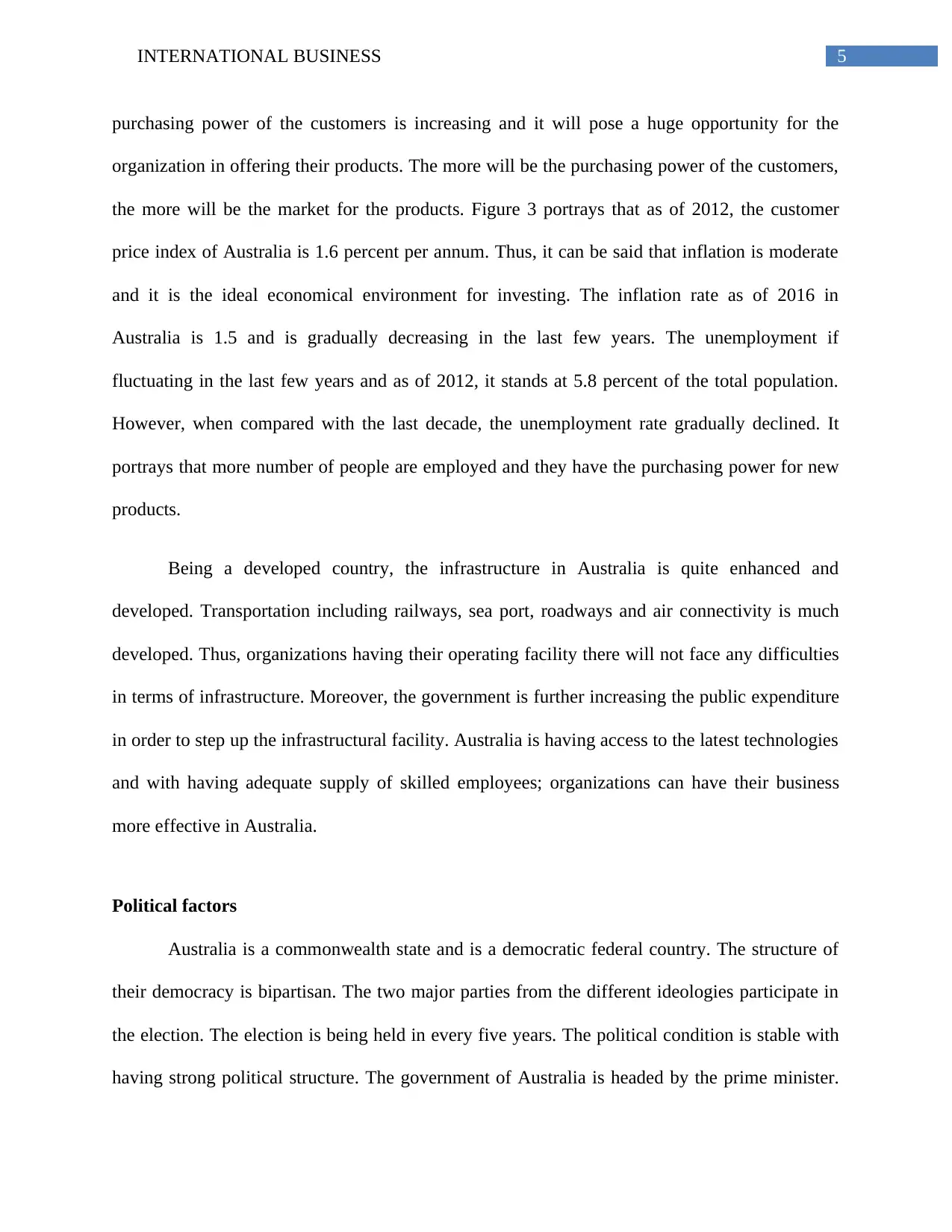
5INTERNATIONAL BUSINESS
purchasing power of the customers is increasing and it will pose a huge opportunity for the
organization in offering their products. The more will be the purchasing power of the customers,
the more will be the market for the products. Figure 3 portrays that as of 2012, the customer
price index of Australia is 1.6 percent per annum. Thus, it can be said that inflation is moderate
and it is the ideal economical environment for investing. The inflation rate as of 2016 in
Australia is 1.5 and is gradually decreasing in the last few years. The unemployment if
fluctuating in the last few years and as of 2012, it stands at 5.8 percent of the total population.
However, when compared with the last decade, the unemployment rate gradually declined. It
portrays that more number of people are employed and they have the purchasing power for new
products.
Being a developed country, the infrastructure in Australia is quite enhanced and
developed. Transportation including railways, sea port, roadways and air connectivity is much
developed. Thus, organizations having their operating facility there will not face any difficulties
in terms of infrastructure. Moreover, the government is further increasing the public expenditure
in order to step up the infrastructural facility. Australia is having access to the latest technologies
and with having adequate supply of skilled employees; organizations can have their business
more effective in Australia.
Political factors
Australia is a commonwealth state and is a democratic federal country. The structure of
their democracy is bipartisan. The two major parties from the different ideologies participate in
the election. The election is being held in every five years. The political condition is stable with
having strong political structure. The government of Australia is headed by the prime minister.
purchasing power of the customers is increasing and it will pose a huge opportunity for the
organization in offering their products. The more will be the purchasing power of the customers,
the more will be the market for the products. Figure 3 portrays that as of 2012, the customer
price index of Australia is 1.6 percent per annum. Thus, it can be said that inflation is moderate
and it is the ideal economical environment for investing. The inflation rate as of 2016 in
Australia is 1.5 and is gradually decreasing in the last few years. The unemployment if
fluctuating in the last few years and as of 2012, it stands at 5.8 percent of the total population.
However, when compared with the last decade, the unemployment rate gradually declined. It
portrays that more number of people are employed and they have the purchasing power for new
products.
Being a developed country, the infrastructure in Australia is quite enhanced and
developed. Transportation including railways, sea port, roadways and air connectivity is much
developed. Thus, organizations having their operating facility there will not face any difficulties
in terms of infrastructure. Moreover, the government is further increasing the public expenditure
in order to step up the infrastructural facility. Australia is having access to the latest technologies
and with having adequate supply of skilled employees; organizations can have their business
more effective in Australia.
Political factors
Australia is a commonwealth state and is a democratic federal country. The structure of
their democracy is bipartisan. The two major parties from the different ideologies participate in
the election. The election is being held in every five years. The political condition is stable with
having strong political structure. The government of Australia is headed by the prime minister.
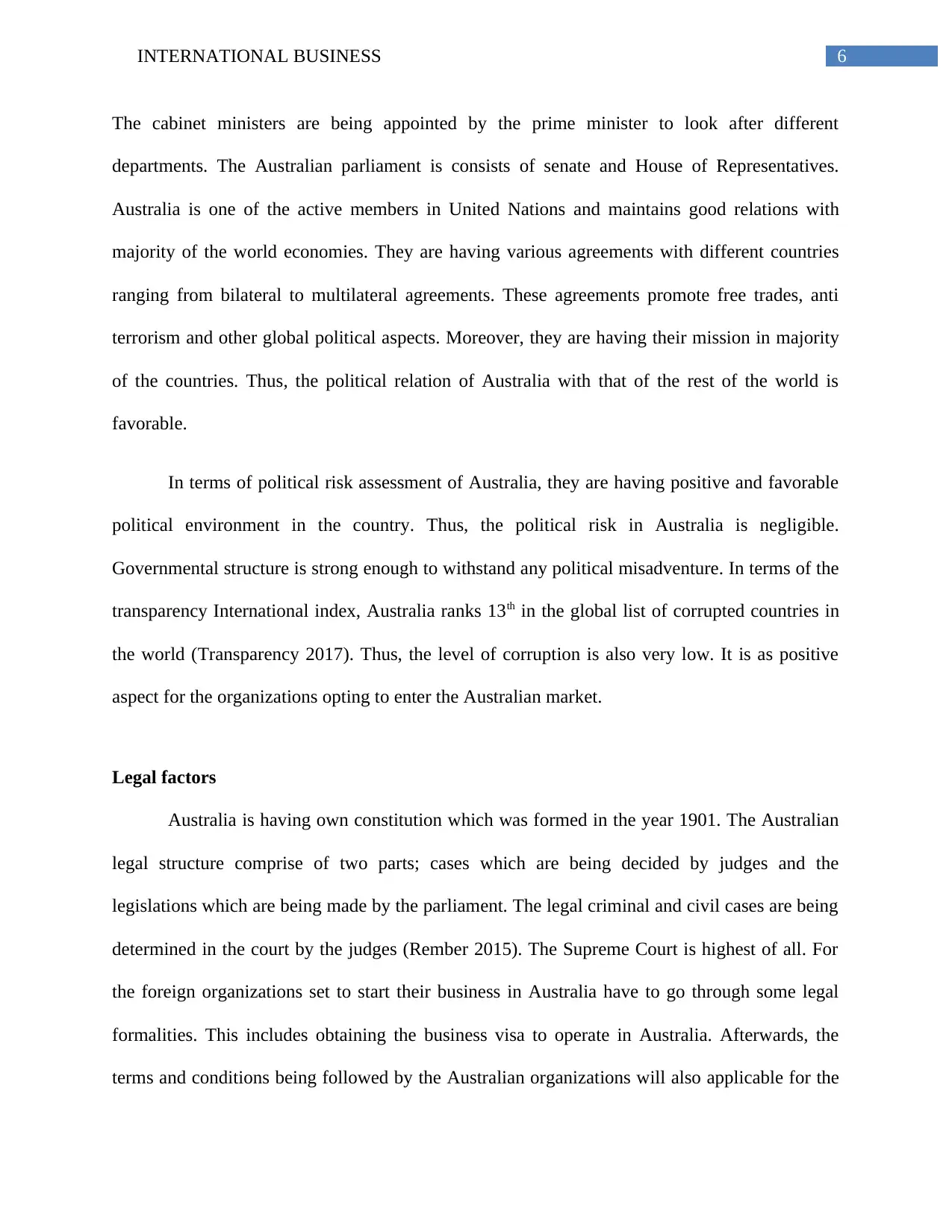
6INTERNATIONAL BUSINESS
The cabinet ministers are being appointed by the prime minister to look after different
departments. The Australian parliament is consists of senate and House of Representatives.
Australia is one of the active members in United Nations and maintains good relations with
majority of the world economies. They are having various agreements with different countries
ranging from bilateral to multilateral agreements. These agreements promote free trades, anti
terrorism and other global political aspects. Moreover, they are having their mission in majority
of the countries. Thus, the political relation of Australia with that of the rest of the world is
favorable.
In terms of political risk assessment of Australia, they are having positive and favorable
political environment in the country. Thus, the political risk in Australia is negligible.
Governmental structure is strong enough to withstand any political misadventure. In terms of the
transparency International index, Australia ranks 13th in the global list of corrupted countries in
the world (Transparency 2017). Thus, the level of corruption is also very low. It is as positive
aspect for the organizations opting to enter the Australian market.
Legal factors
Australia is having own constitution which was formed in the year 1901. The Australian
legal structure comprise of two parts; cases which are being decided by judges and the
legislations which are being made by the parliament. The legal criminal and civil cases are being
determined in the court by the judges (Rember 2015). The Supreme Court is highest of all. For
the foreign organizations set to start their business in Australia have to go through some legal
formalities. This includes obtaining the business visa to operate in Australia. Afterwards, the
terms and conditions being followed by the Australian organizations will also applicable for the
The cabinet ministers are being appointed by the prime minister to look after different
departments. The Australian parliament is consists of senate and House of Representatives.
Australia is one of the active members in United Nations and maintains good relations with
majority of the world economies. They are having various agreements with different countries
ranging from bilateral to multilateral agreements. These agreements promote free trades, anti
terrorism and other global political aspects. Moreover, they are having their mission in majority
of the countries. Thus, the political relation of Australia with that of the rest of the world is
favorable.
In terms of political risk assessment of Australia, they are having positive and favorable
political environment in the country. Thus, the political risk in Australia is negligible.
Governmental structure is strong enough to withstand any political misadventure. In terms of the
transparency International index, Australia ranks 13th in the global list of corrupted countries in
the world (Transparency 2017). Thus, the level of corruption is also very low. It is as positive
aspect for the organizations opting to enter the Australian market.
Legal factors
Australia is having own constitution which was formed in the year 1901. The Australian
legal structure comprise of two parts; cases which are being decided by judges and the
legislations which are being made by the parliament. The legal criminal and civil cases are being
determined in the court by the judges (Rember 2015). The Supreme Court is highest of all. For
the foreign organizations set to start their business in Australia have to go through some legal
formalities. This includes obtaining the business visa to operate in Australia. Afterwards, the
terms and conditions being followed by the Australian organizations will also applicable for the
Paraphrase This Document
Need a fresh take? Get an instant paraphrase of this document with our AI Paraphraser
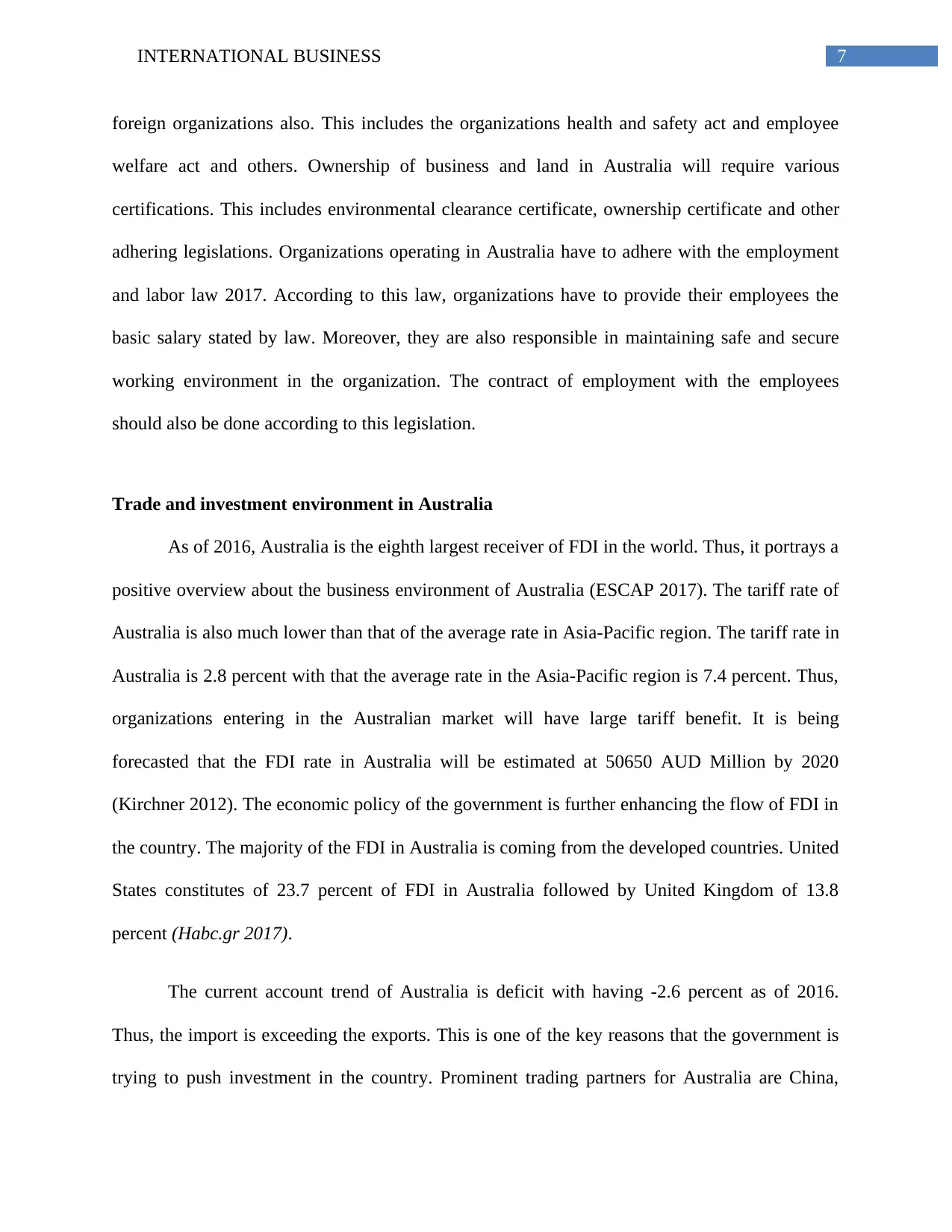
7INTERNATIONAL BUSINESS
foreign organizations also. This includes the organizations health and safety act and employee
welfare act and others. Ownership of business and land in Australia will require various
certifications. This includes environmental clearance certificate, ownership certificate and other
adhering legislations. Organizations operating in Australia have to adhere with the employment
and labor law 2017. According to this law, organizations have to provide their employees the
basic salary stated by law. Moreover, they are also responsible in maintaining safe and secure
working environment in the organization. The contract of employment with the employees
should also be done according to this legislation.
Trade and investment environment in Australia
As of 2016, Australia is the eighth largest receiver of FDI in the world. Thus, it portrays a
positive overview about the business environment of Australia (ESCAP 2017). The tariff rate of
Australia is also much lower than that of the average rate in Asia-Pacific region. The tariff rate in
Australia is 2.8 percent with that the average rate in the Asia-Pacific region is 7.4 percent. Thus,
organizations entering in the Australian market will have large tariff benefit. It is being
forecasted that the FDI rate in Australia will be estimated at 50650 AUD Million by 2020
(Kirchner 2012). The economic policy of the government is further enhancing the flow of FDI in
the country. The majority of the FDI in Australia is coming from the developed countries. United
States constitutes of 23.7 percent of FDI in Australia followed by United Kingdom of 13.8
percent (Habc.gr 2017).
The current account trend of Australia is deficit with having -2.6 percent as of 2016.
Thus, the import is exceeding the exports. This is one of the key reasons that the government is
trying to push investment in the country. Prominent trading partners for Australia are China,
foreign organizations also. This includes the organizations health and safety act and employee
welfare act and others. Ownership of business and land in Australia will require various
certifications. This includes environmental clearance certificate, ownership certificate and other
adhering legislations. Organizations operating in Australia have to adhere with the employment
and labor law 2017. According to this law, organizations have to provide their employees the
basic salary stated by law. Moreover, they are also responsible in maintaining safe and secure
working environment in the organization. The contract of employment with the employees
should also be done according to this legislation.
Trade and investment environment in Australia
As of 2016, Australia is the eighth largest receiver of FDI in the world. Thus, it portrays a
positive overview about the business environment of Australia (ESCAP 2017). The tariff rate of
Australia is also much lower than that of the average rate in Asia-Pacific region. The tariff rate in
Australia is 2.8 percent with that the average rate in the Asia-Pacific region is 7.4 percent. Thus,
organizations entering in the Australian market will have large tariff benefit. It is being
forecasted that the FDI rate in Australia will be estimated at 50650 AUD Million by 2020
(Kirchner 2012). The economic policy of the government is further enhancing the flow of FDI in
the country. The majority of the FDI in Australia is coming from the developed countries. United
States constitutes of 23.7 percent of FDI in Australia followed by United Kingdom of 13.8
percent (Habc.gr 2017).
The current account trend of Australia is deficit with having -2.6 percent as of 2016.
Thus, the import is exceeding the exports. This is one of the key reasons that the government is
trying to push investment in the country. Prominent trading partners for Australia are China,
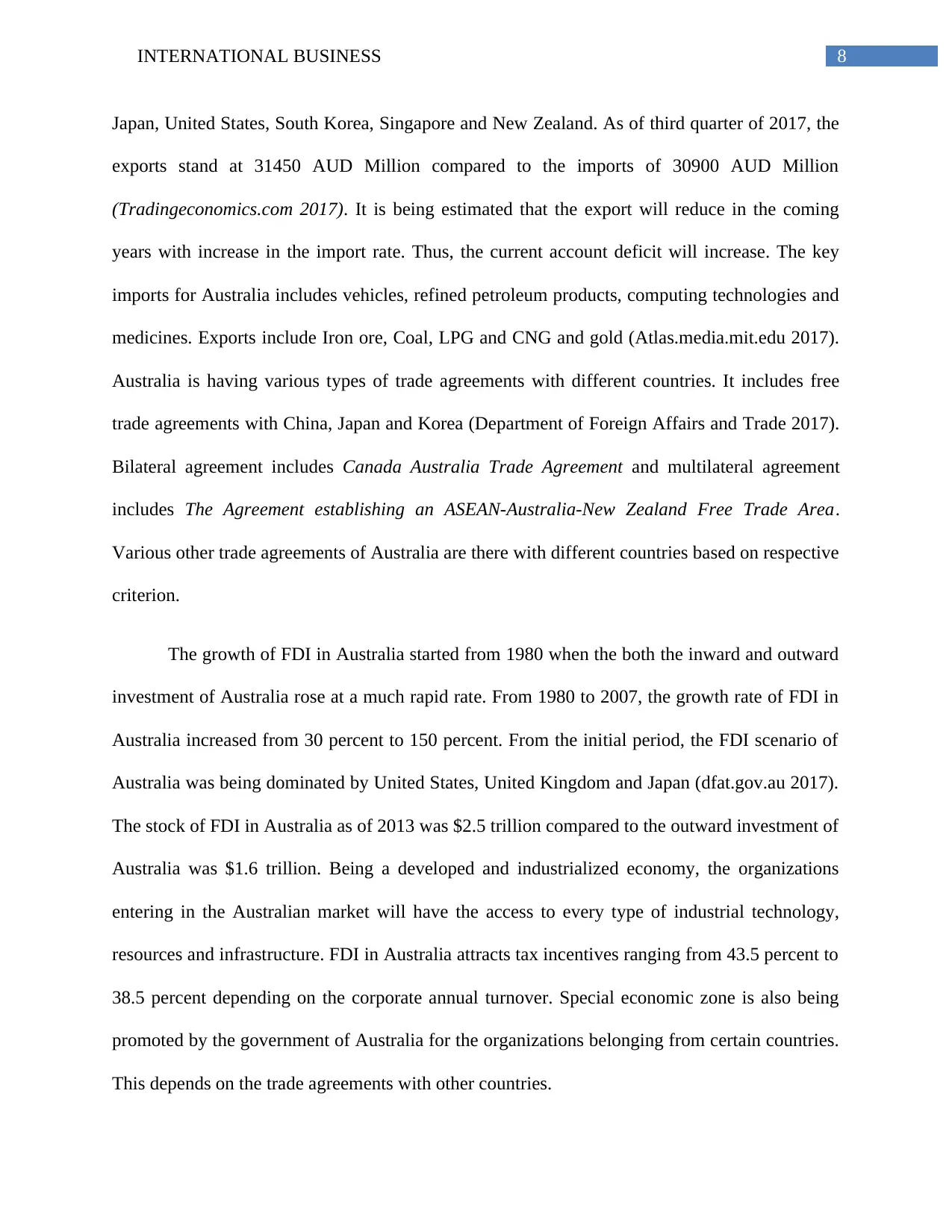
8INTERNATIONAL BUSINESS
Japan, United States, South Korea, Singapore and New Zealand. As of third quarter of 2017, the
exports stand at 31450 AUD Million compared to the imports of 30900 AUD Million
(Tradingeconomics.com 2017). It is being estimated that the export will reduce in the coming
years with increase in the import rate. Thus, the current account deficit will increase. The key
imports for Australia includes vehicles, refined petroleum products, computing technologies and
medicines. Exports include Iron ore, Coal, LPG and CNG and gold (Atlas.media.mit.edu 2017).
Australia is having various types of trade agreements with different countries. It includes free
trade agreements with China, Japan and Korea (Department of Foreign Affairs and Trade 2017).
Bilateral agreement includes Canada Australia Trade Agreement and multilateral agreement
includes The Agreement establishing an ASEAN-Australia-New Zealand Free Trade Area.
Various other trade agreements of Australia are there with different countries based on respective
criterion.
The growth of FDI in Australia started from 1980 when the both the inward and outward
investment of Australia rose at a much rapid rate. From 1980 to 2007, the growth rate of FDI in
Australia increased from 30 percent to 150 percent. From the initial period, the FDI scenario of
Australia was being dominated by United States, United Kingdom and Japan (dfat.gov.au 2017).
The stock of FDI in Australia as of 2013 was $2.5 trillion compared to the outward investment of
Australia was $1.6 trillion. Being a developed and industrialized economy, the organizations
entering in the Australian market will have the access to every type of industrial technology,
resources and infrastructure. FDI in Australia attracts tax incentives ranging from 43.5 percent to
38.5 percent depending on the corporate annual turnover. Special economic zone is also being
promoted by the government of Australia for the organizations belonging from certain countries.
This depends on the trade agreements with other countries.
Japan, United States, South Korea, Singapore and New Zealand. As of third quarter of 2017, the
exports stand at 31450 AUD Million compared to the imports of 30900 AUD Million
(Tradingeconomics.com 2017). It is being estimated that the export will reduce in the coming
years with increase in the import rate. Thus, the current account deficit will increase. The key
imports for Australia includes vehicles, refined petroleum products, computing technologies and
medicines. Exports include Iron ore, Coal, LPG and CNG and gold (Atlas.media.mit.edu 2017).
Australia is having various types of trade agreements with different countries. It includes free
trade agreements with China, Japan and Korea (Department of Foreign Affairs and Trade 2017).
Bilateral agreement includes Canada Australia Trade Agreement and multilateral agreement
includes The Agreement establishing an ASEAN-Australia-New Zealand Free Trade Area.
Various other trade agreements of Australia are there with different countries based on respective
criterion.
The growth of FDI in Australia started from 1980 when the both the inward and outward
investment of Australia rose at a much rapid rate. From 1980 to 2007, the growth rate of FDI in
Australia increased from 30 percent to 150 percent. From the initial period, the FDI scenario of
Australia was being dominated by United States, United Kingdom and Japan (dfat.gov.au 2017).
The stock of FDI in Australia as of 2013 was $2.5 trillion compared to the outward investment of
Australia was $1.6 trillion. Being a developed and industrialized economy, the organizations
entering in the Australian market will have the access to every type of industrial technology,
resources and infrastructure. FDI in Australia attracts tax incentives ranging from 43.5 percent to
38.5 percent depending on the corporate annual turnover. Special economic zone is also being
promoted by the government of Australia for the organizations belonging from certain countries.
This depends on the trade agreements with other countries.
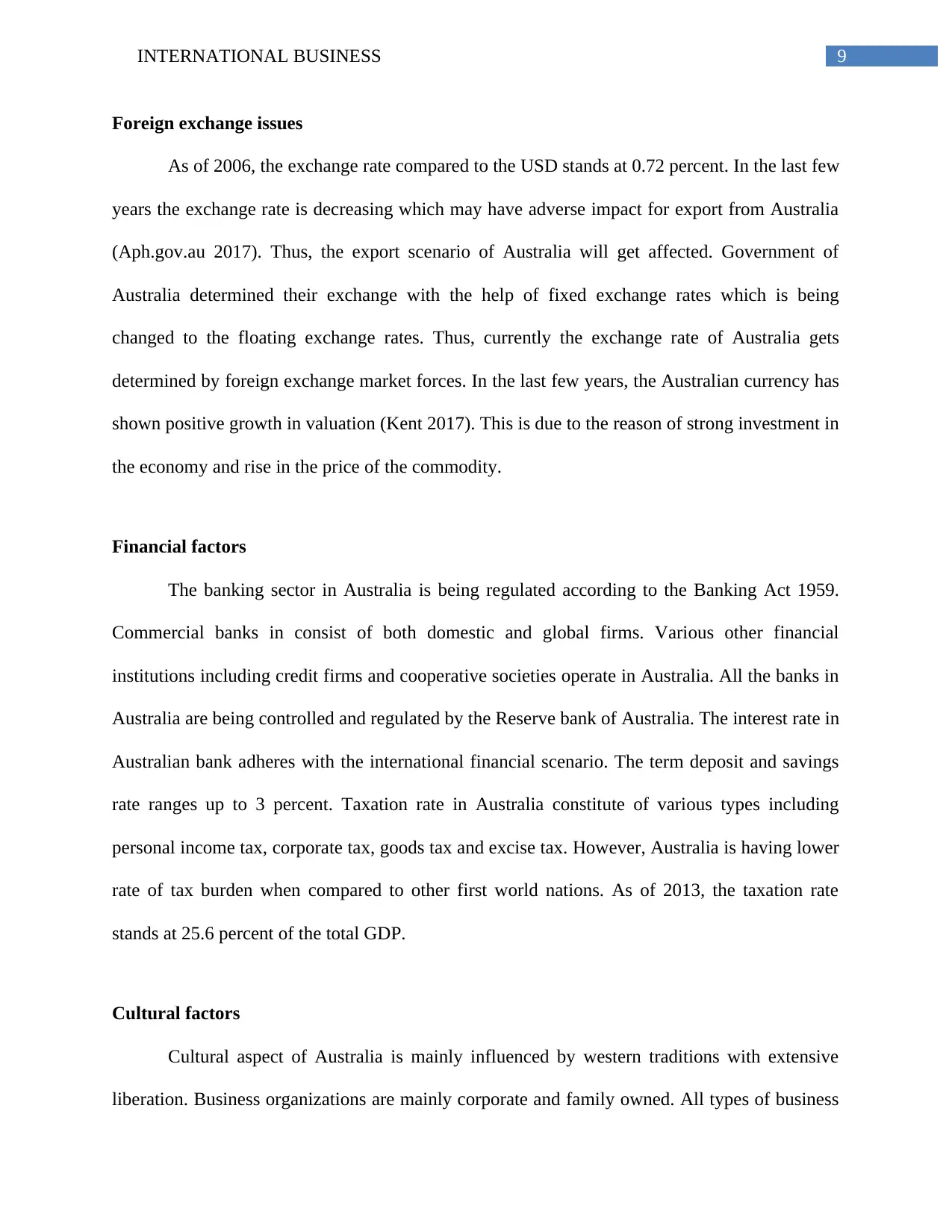
9INTERNATIONAL BUSINESS
Foreign exchange issues
As of 2006, the exchange rate compared to the USD stands at 0.72 percent. In the last few
years the exchange rate is decreasing which may have adverse impact for export from Australia
(Aph.gov.au 2017). Thus, the export scenario of Australia will get affected. Government of
Australia determined their exchange with the help of fixed exchange rates which is being
changed to the floating exchange rates. Thus, currently the exchange rate of Australia gets
determined by foreign exchange market forces. In the last few years, the Australian currency has
shown positive growth in valuation (Kent 2017). This is due to the reason of strong investment in
the economy and rise in the price of the commodity.
Financial factors
The banking sector in Australia is being regulated according to the Banking Act 1959.
Commercial banks in consist of both domestic and global firms. Various other financial
institutions including credit firms and cooperative societies operate in Australia. All the banks in
Australia are being controlled and regulated by the Reserve bank of Australia. The interest rate in
Australian bank adheres with the international financial scenario. The term deposit and savings
rate ranges up to 3 percent. Taxation rate in Australia constitute of various types including
personal income tax, corporate tax, goods tax and excise tax. However, Australia is having lower
rate of tax burden when compared to other first world nations. As of 2013, the taxation rate
stands at 25.6 percent of the total GDP.
Cultural factors
Cultural aspect of Australia is mainly influenced by western traditions with extensive
liberation. Business organizations are mainly corporate and family owned. All types of business
Foreign exchange issues
As of 2006, the exchange rate compared to the USD stands at 0.72 percent. In the last few
years the exchange rate is decreasing which may have adverse impact for export from Australia
(Aph.gov.au 2017). Thus, the export scenario of Australia will get affected. Government of
Australia determined their exchange with the help of fixed exchange rates which is being
changed to the floating exchange rates. Thus, currently the exchange rate of Australia gets
determined by foreign exchange market forces. In the last few years, the Australian currency has
shown positive growth in valuation (Kent 2017). This is due to the reason of strong investment in
the economy and rise in the price of the commodity.
Financial factors
The banking sector in Australia is being regulated according to the Banking Act 1959.
Commercial banks in consist of both domestic and global firms. Various other financial
institutions including credit firms and cooperative societies operate in Australia. All the banks in
Australia are being controlled and regulated by the Reserve bank of Australia. The interest rate in
Australian bank adheres with the international financial scenario. The term deposit and savings
rate ranges up to 3 percent. Taxation rate in Australia constitute of various types including
personal income tax, corporate tax, goods tax and excise tax. However, Australia is having lower
rate of tax burden when compared to other first world nations. As of 2013, the taxation rate
stands at 25.6 percent of the total GDP.
Cultural factors
Cultural aspect of Australia is mainly influenced by western traditions with extensive
liberation. Business organizations are mainly corporate and family owned. All types of business
Secure Best Marks with AI Grader
Need help grading? Try our AI Grader for instant feedback on your assignments.
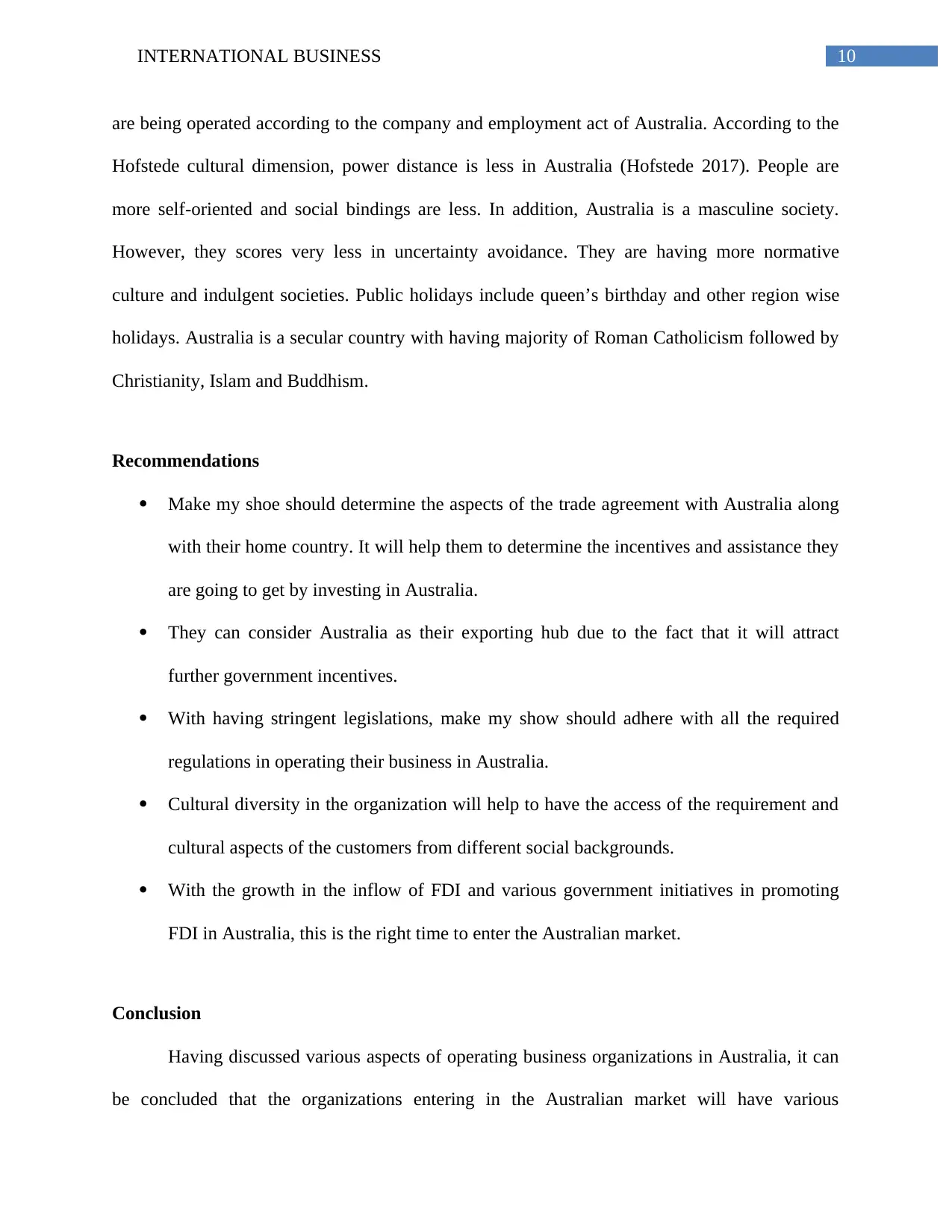
10INTERNATIONAL BUSINESS
are being operated according to the company and employment act of Australia. According to the
Hofstede cultural dimension, power distance is less in Australia (Hofstede 2017). People are
more self-oriented and social bindings are less. In addition, Australia is a masculine society.
However, they scores very less in uncertainty avoidance. They are having more normative
culture and indulgent societies. Public holidays include queen’s birthday and other region wise
holidays. Australia is a secular country with having majority of Roman Catholicism followed by
Christianity, Islam and Buddhism.
Recommendations
Make my shoe should determine the aspects of the trade agreement with Australia along
with their home country. It will help them to determine the incentives and assistance they
are going to get by investing in Australia.
They can consider Australia as their exporting hub due to the fact that it will attract
further government incentives.
With having stringent legislations, make my show should adhere with all the required
regulations in operating their business in Australia.
Cultural diversity in the organization will help to have the access of the requirement and
cultural aspects of the customers from different social backgrounds.
With the growth in the inflow of FDI and various government initiatives in promoting
FDI in Australia, this is the right time to enter the Australian market.
Conclusion
Having discussed various aspects of operating business organizations in Australia, it can
be concluded that the organizations entering in the Australian market will have various
are being operated according to the company and employment act of Australia. According to the
Hofstede cultural dimension, power distance is less in Australia (Hofstede 2017). People are
more self-oriented and social bindings are less. In addition, Australia is a masculine society.
However, they scores very less in uncertainty avoidance. They are having more normative
culture and indulgent societies. Public holidays include queen’s birthday and other region wise
holidays. Australia is a secular country with having majority of Roman Catholicism followed by
Christianity, Islam and Buddhism.
Recommendations
Make my shoe should determine the aspects of the trade agreement with Australia along
with their home country. It will help them to determine the incentives and assistance they
are going to get by investing in Australia.
They can consider Australia as their exporting hub due to the fact that it will attract
further government incentives.
With having stringent legislations, make my show should adhere with all the required
regulations in operating their business in Australia.
Cultural diversity in the organization will help to have the access of the requirement and
cultural aspects of the customers from different social backgrounds.
With the growth in the inflow of FDI and various government initiatives in promoting
FDI in Australia, this is the right time to enter the Australian market.
Conclusion
Having discussed various aspects of operating business organizations in Australia, it can
be concluded that the organizations entering in the Australian market will have various
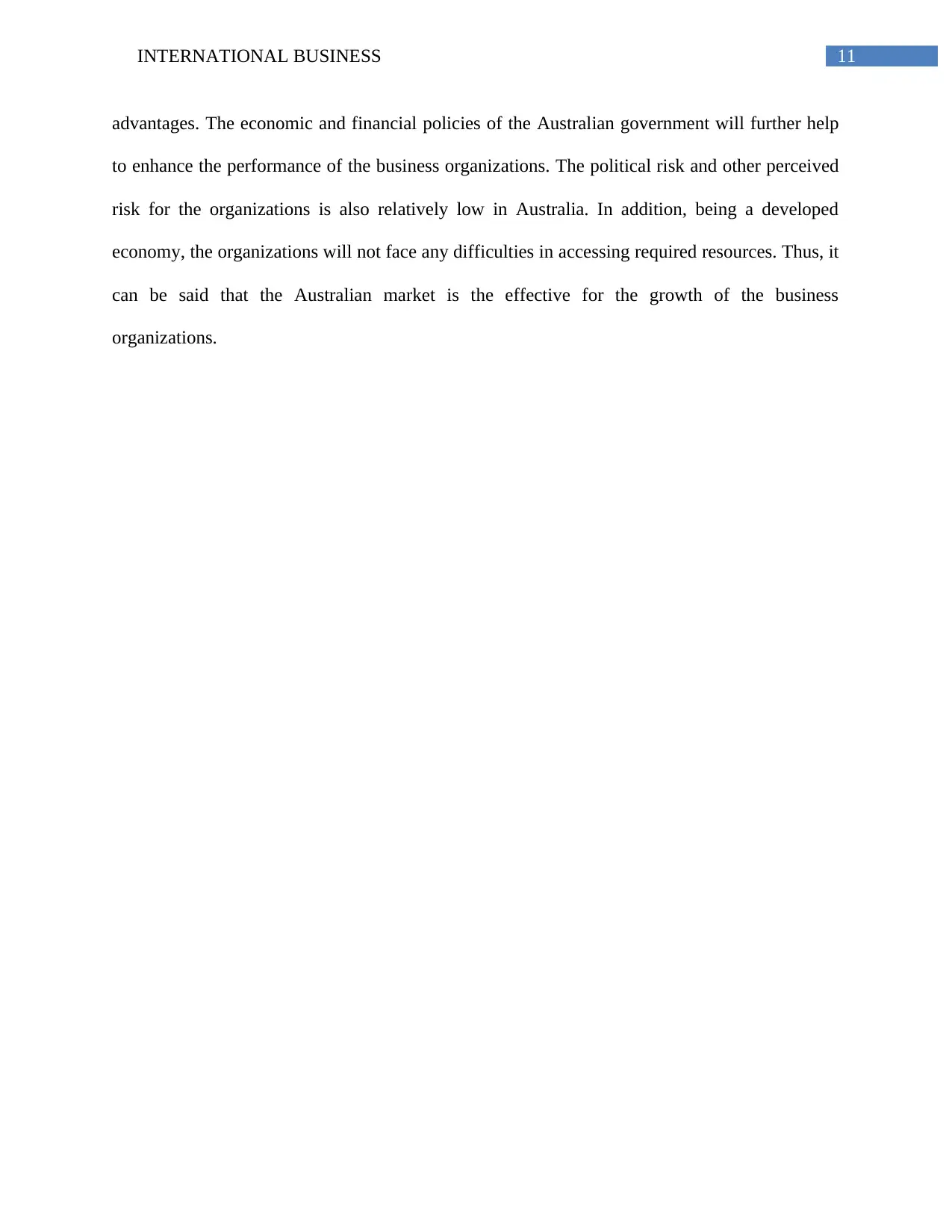
11INTERNATIONAL BUSINESS
advantages. The economic and financial policies of the Australian government will further help
to enhance the performance of the business organizations. The political risk and other perceived
risk for the organizations is also relatively low in Australia. In addition, being a developed
economy, the organizations will not face any difficulties in accessing required resources. Thus, it
can be said that the Australian market is the effective for the growth of the business
organizations.
advantages. The economic and financial policies of the Australian government will further help
to enhance the performance of the business organizations. The political risk and other perceived
risk for the organizations is also relatively low in Australia. In addition, being a developed
economy, the organizations will not face any difficulties in accessing required resources. Thus, it
can be said that the Australian market is the effective for the growth of the business
organizations.
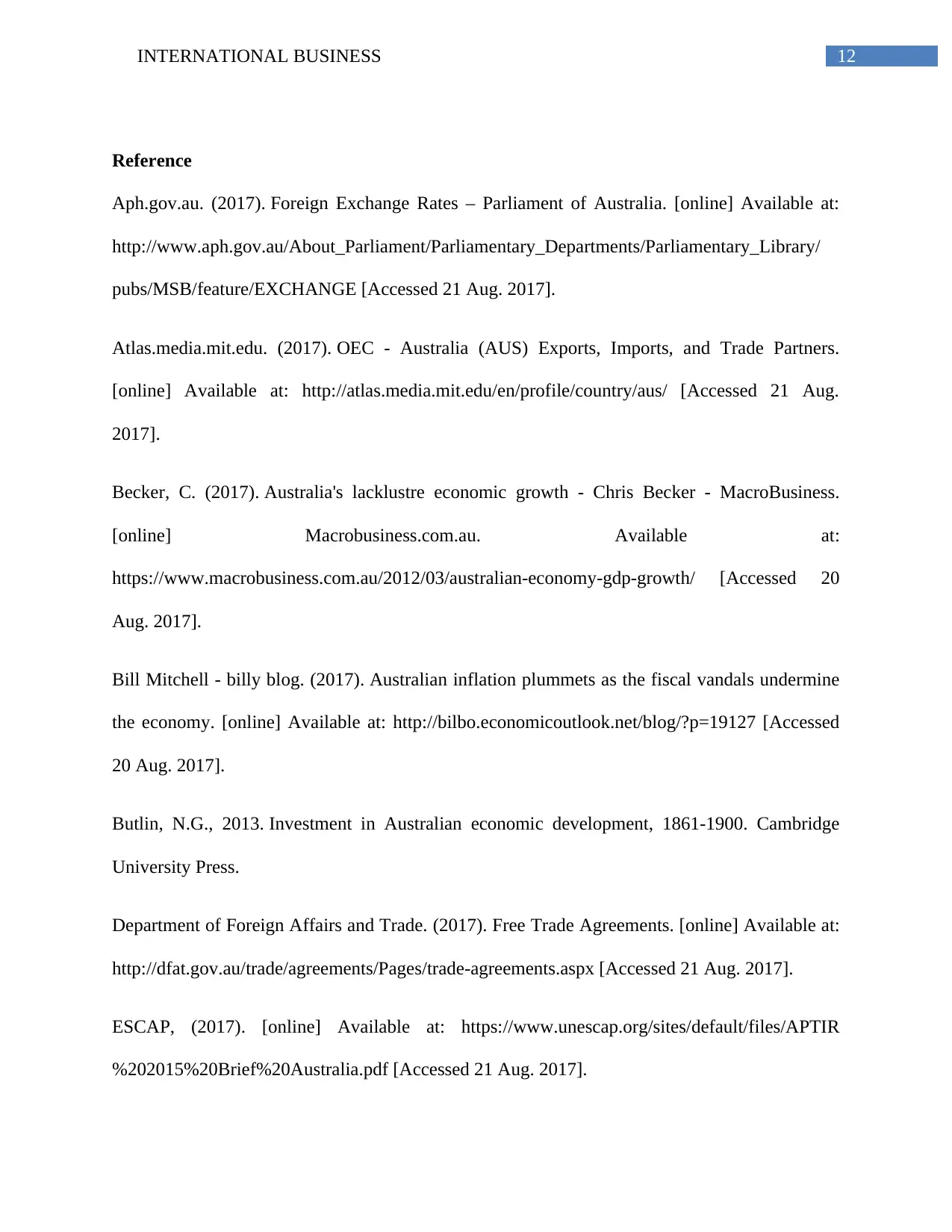
12INTERNATIONAL BUSINESS
Reference
Aph.gov.au. (2017). Foreign Exchange Rates – Parliament of Australia. [online] Available at:
http://www.aph.gov.au/About_Parliament/Parliamentary_Departments/Parliamentary_Library/
pubs/MSB/feature/EXCHANGE [Accessed 21 Aug. 2017].
Atlas.media.mit.edu. (2017). OEC - Australia (AUS) Exports, Imports, and Trade Partners.
[online] Available at: http://atlas.media.mit.edu/en/profile/country/aus/ [Accessed 21 Aug.
2017].
Becker, C. (2017). Australia's lacklustre economic growth - Chris Becker - MacroBusiness.
[online] Macrobusiness.com.au. Available at:
https://www.macrobusiness.com.au/2012/03/australian-economy-gdp-growth/ [Accessed 20
Aug. 2017].
Bill Mitchell - billy blog. (2017). Australian inflation plummets as the fiscal vandals undermine
the economy. [online] Available at: http://bilbo.economicoutlook.net/blog/?p=19127 [Accessed
20 Aug. 2017].
Butlin, N.G., 2013. Investment in Australian economic development, 1861-1900. Cambridge
University Press.
Department of Foreign Affairs and Trade. (2017). Free Trade Agreements. [online] Available at:
http://dfat.gov.au/trade/agreements/Pages/trade-agreements.aspx [Accessed 21 Aug. 2017].
ESCAP, (2017). [online] Available at: https://www.unescap.org/sites/default/files/APTIR
%202015%20Brief%20Australia.pdf [Accessed 21 Aug. 2017].
Reference
Aph.gov.au. (2017). Foreign Exchange Rates – Parliament of Australia. [online] Available at:
http://www.aph.gov.au/About_Parliament/Parliamentary_Departments/Parliamentary_Library/
pubs/MSB/feature/EXCHANGE [Accessed 21 Aug. 2017].
Atlas.media.mit.edu. (2017). OEC - Australia (AUS) Exports, Imports, and Trade Partners.
[online] Available at: http://atlas.media.mit.edu/en/profile/country/aus/ [Accessed 21 Aug.
2017].
Becker, C. (2017). Australia's lacklustre economic growth - Chris Becker - MacroBusiness.
[online] Macrobusiness.com.au. Available at:
https://www.macrobusiness.com.au/2012/03/australian-economy-gdp-growth/ [Accessed 20
Aug. 2017].
Bill Mitchell - billy blog. (2017). Australian inflation plummets as the fiscal vandals undermine
the economy. [online] Available at: http://bilbo.economicoutlook.net/blog/?p=19127 [Accessed
20 Aug. 2017].
Butlin, N.G., 2013. Investment in Australian economic development, 1861-1900. Cambridge
University Press.
Department of Foreign Affairs and Trade. (2017). Free Trade Agreements. [online] Available at:
http://dfat.gov.au/trade/agreements/Pages/trade-agreements.aspx [Accessed 21 Aug. 2017].
ESCAP, (2017). [online] Available at: https://www.unescap.org/sites/default/files/APTIR
%202015%20Brief%20Australia.pdf [Accessed 21 Aug. 2017].
Paraphrase This Document
Need a fresh take? Get an instant paraphrase of this document with our AI Paraphraser

13INTERNATIONAL BUSINESS
FocusEconomics | Economic Forecasts from the World's Leading Economists. (2017). Australia
Inflation Rate (CPI, eop) - FocusEconomics. [online] Available at: http://www.focus-
economics.com/country-indicator/australia/inflation-eop [Accessed 20 Aug. 2017].
Habc.gr. (2017). Foreign direct investment (FDI) in Australia. [online] Available at:
http://www.habc.gr/australia_fdi.asp [Accessed 21 Aug. 2017].
Hofstede, G. (2017). Australia - Geert Hofstede. [online] Geert-hofstede.com. Available at:
https://geert-hofstede.com/australia.html [Accessed 21 Aug. 2017].
Holes, H. (2017). Parko puts 'em to sleep - MacroBusiness. [online] Macrobusiness.com.au.
Available at: https://www.macrobusiness.com.au/2011/08/parko-puts-em-to-sleep/ [Accessed 20
Aug. 2017].
Kent, C. (2017). The Resources Boom and the Australian Dollar | Speeches | RBA. [online]
Reserve Bank of Australia. Available at: http://www.rba.gov.au/speeches/2014/sp-ag-
140214.html [Accessed 21 Aug. 2017].
Kirchner, S., 2012. Foreign direct investment in Australia following the Australia–US free trade
agreement. Australian Economic Review, 45(4), pp.410-421.
Marques, C.S., Leal, C., Marques, C.P. and Cardoso, A.R., 2016. Strategic knowledge
management, innovation and performance: a qualitative study of the footwear industry. Journal
of the Knowledge Economy, 7(3), pp.659-675.
Rembar, C., 2015. The law of the land: The evolution of our legal system. Open Road Media.
FocusEconomics | Economic Forecasts from the World's Leading Economists. (2017). Australia
Inflation Rate (CPI, eop) - FocusEconomics. [online] Available at: http://www.focus-
economics.com/country-indicator/australia/inflation-eop [Accessed 20 Aug. 2017].
Habc.gr. (2017). Foreign direct investment (FDI) in Australia. [online] Available at:
http://www.habc.gr/australia_fdi.asp [Accessed 21 Aug. 2017].
Hofstede, G. (2017). Australia - Geert Hofstede. [online] Geert-hofstede.com. Available at:
https://geert-hofstede.com/australia.html [Accessed 21 Aug. 2017].
Holes, H. (2017). Parko puts 'em to sleep - MacroBusiness. [online] Macrobusiness.com.au.
Available at: https://www.macrobusiness.com.au/2011/08/parko-puts-em-to-sleep/ [Accessed 20
Aug. 2017].
Kent, C. (2017). The Resources Boom and the Australian Dollar | Speeches | RBA. [online]
Reserve Bank of Australia. Available at: http://www.rba.gov.au/speeches/2014/sp-ag-
140214.html [Accessed 21 Aug. 2017].
Kirchner, S., 2012. Foreign direct investment in Australia following the Australia–US free trade
agreement. Australian Economic Review, 45(4), pp.410-421.
Marques, C.S., Leal, C., Marques, C.P. and Cardoso, A.R., 2016. Strategic knowledge
management, innovation and performance: a qualitative study of the footwear industry. Journal
of the Knowledge Economy, 7(3), pp.659-675.
Rembar, C., 2015. The law of the land: The evolution of our legal system. Open Road Media.
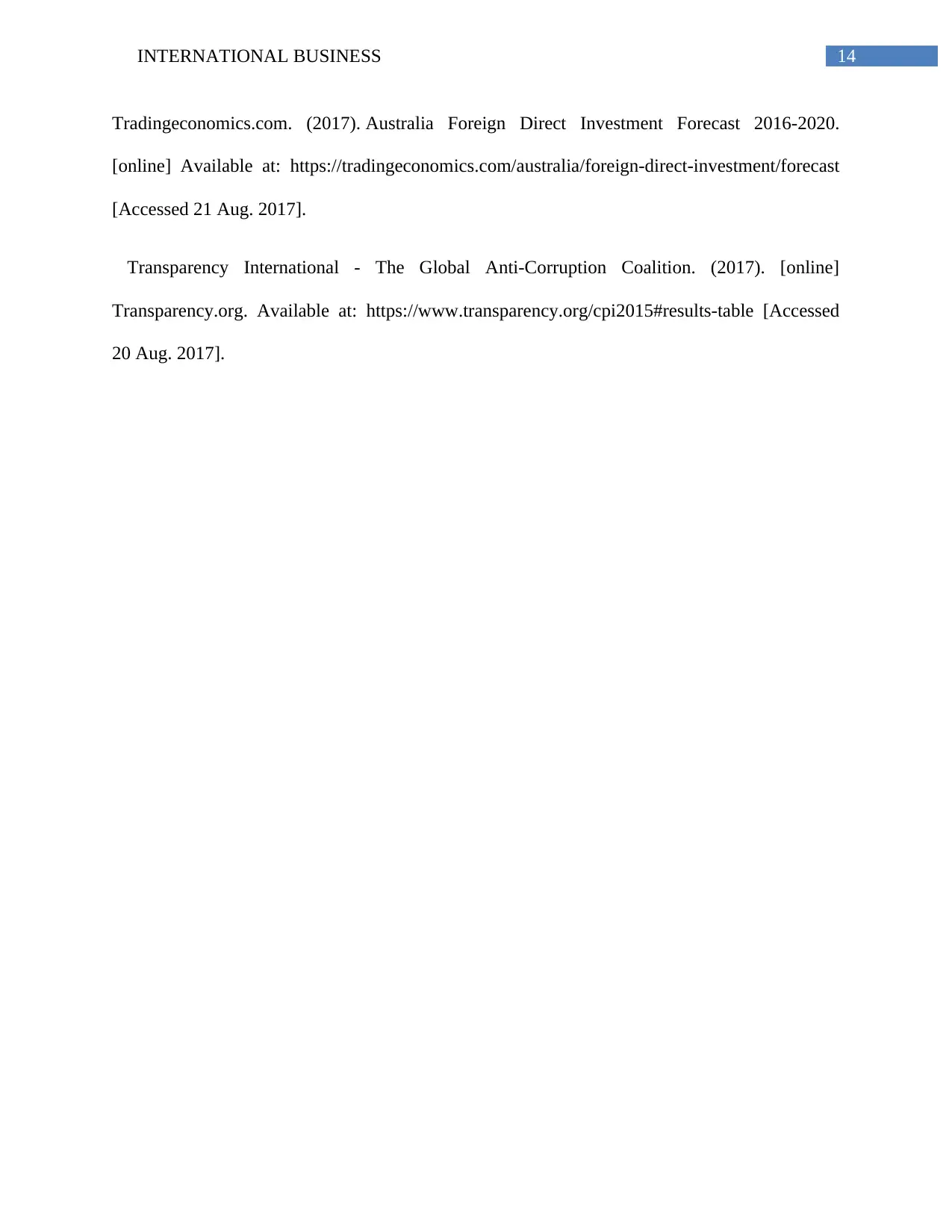
14INTERNATIONAL BUSINESS
Tradingeconomics.com. (2017). Australia Foreign Direct Investment Forecast 2016-2020.
[online] Available at: https://tradingeconomics.com/australia/foreign-direct-investment/forecast
[Accessed 21 Aug. 2017].
Transparency International - The Global Anti-Corruption Coalition. (2017). [online]
Transparency.org. Available at: https://www.transparency.org/cpi2015#results-table [Accessed
20 Aug. 2017].
Tradingeconomics.com. (2017). Australia Foreign Direct Investment Forecast 2016-2020.
[online] Available at: https://tradingeconomics.com/australia/foreign-direct-investment/forecast
[Accessed 21 Aug. 2017].
Transparency International - The Global Anti-Corruption Coalition. (2017). [online]
Transparency.org. Available at: https://www.transparency.org/cpi2015#results-table [Accessed
20 Aug. 2017].
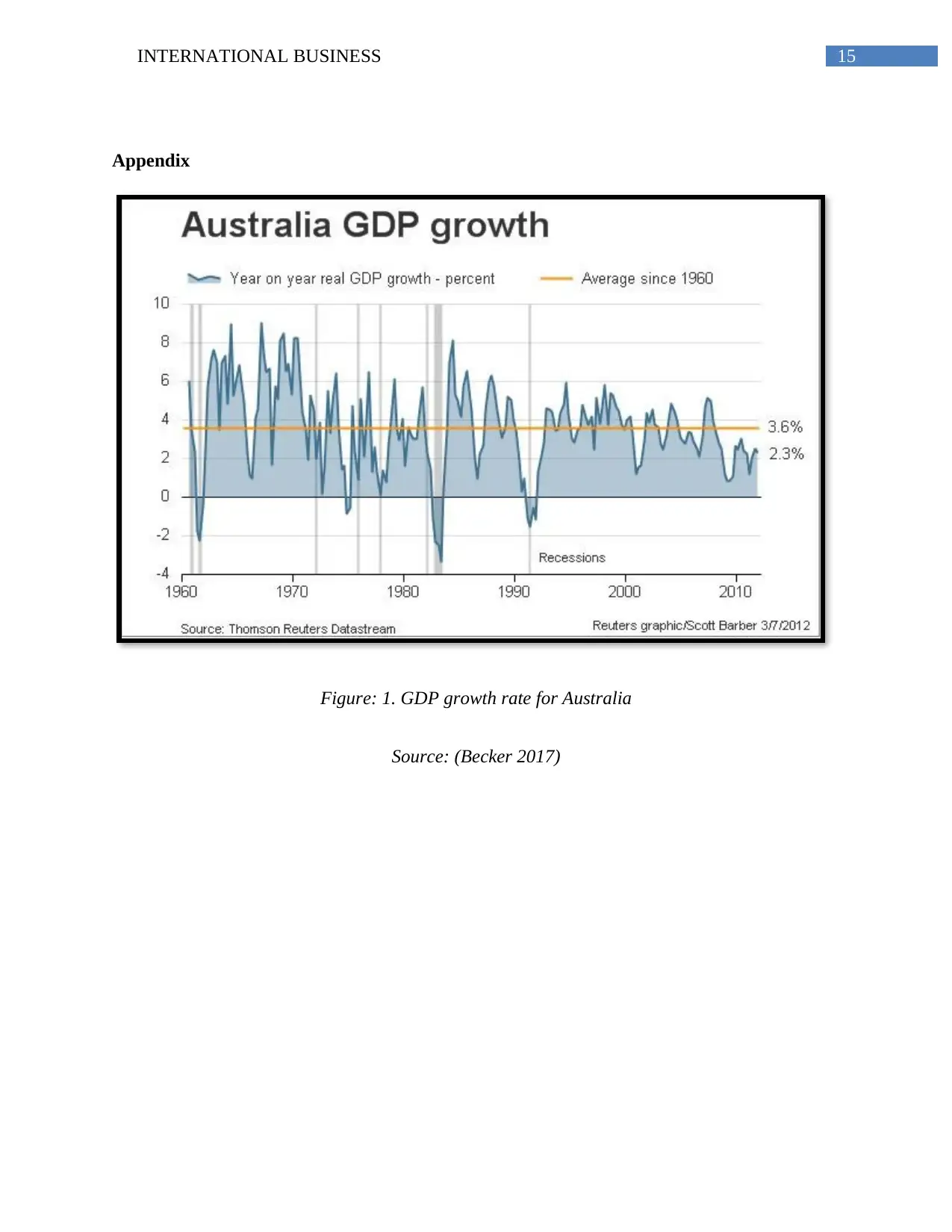
15INTERNATIONAL BUSINESS
Appendix
Figure: 1. GDP growth rate for Australia
Source: (Becker 2017)
Appendix
Figure: 1. GDP growth rate for Australia
Source: (Becker 2017)
Secure Best Marks with AI Grader
Need help grading? Try our AI Grader for instant feedback on your assignments.
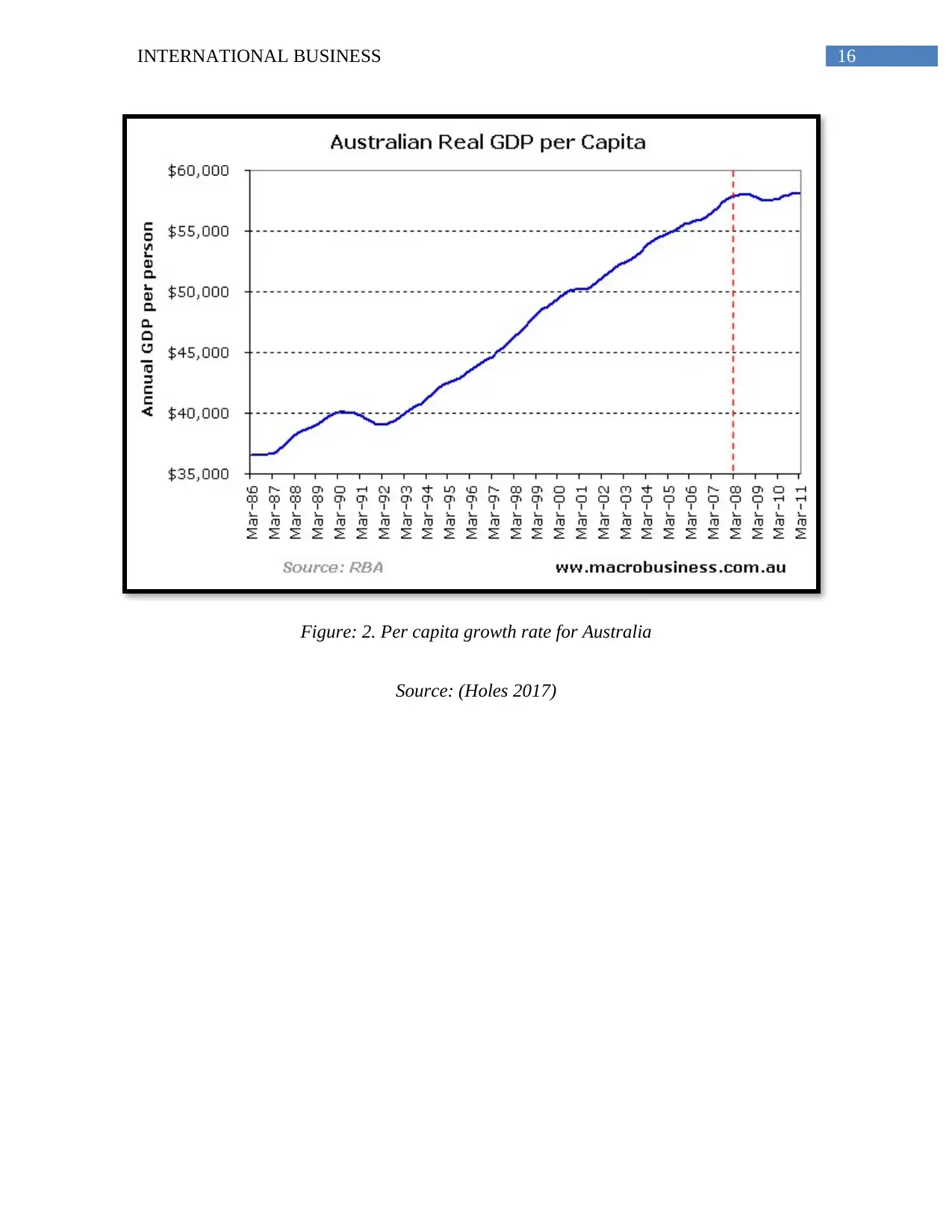
16INTERNATIONAL BUSINESS
Figure: 2. Per capita growth rate for Australia
Source: (Holes 2017)
Figure: 2. Per capita growth rate for Australia
Source: (Holes 2017)
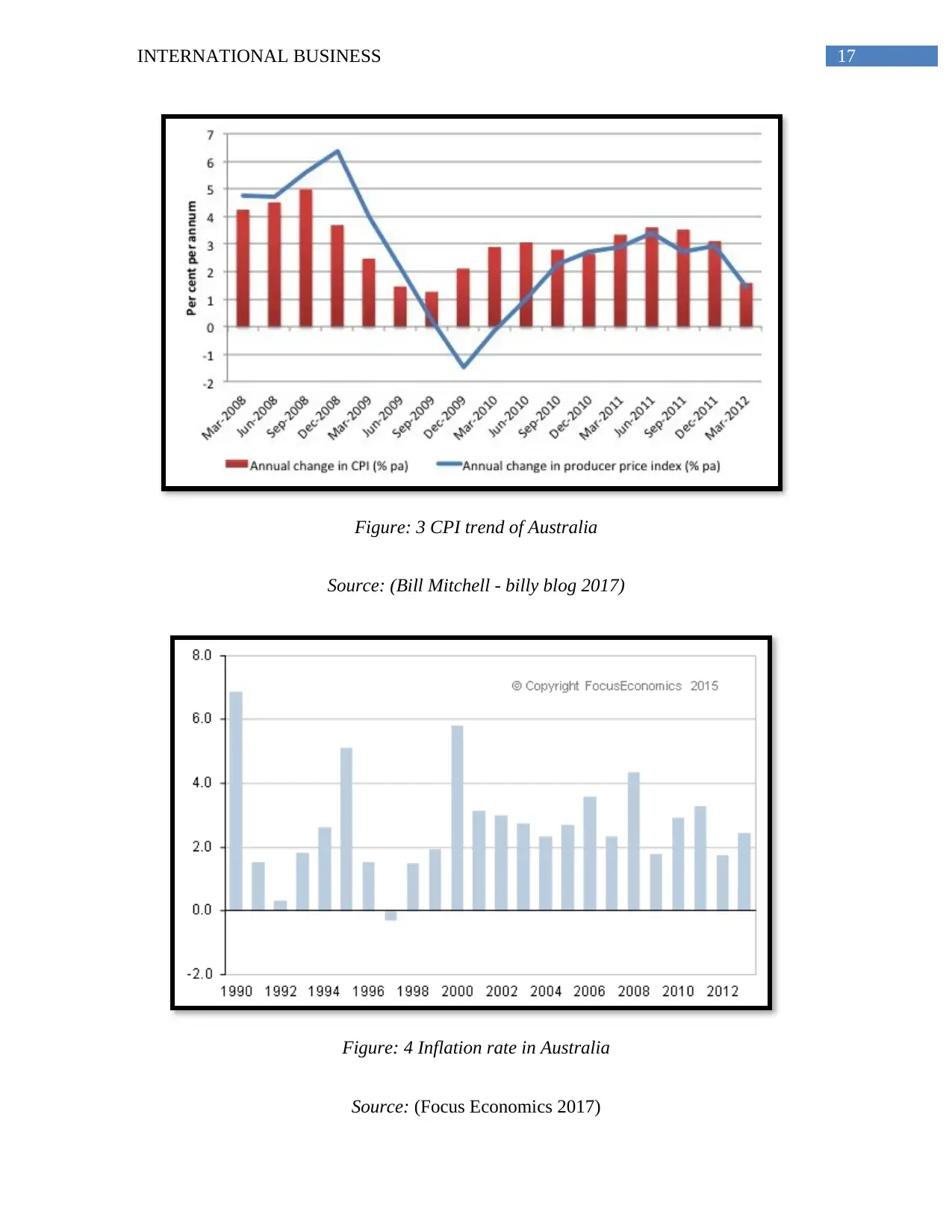
17INTERNATIONAL BUSINESS
Figure: 3 CPI trend of Australia
Source: (Bill Mitchell - billy blog 2017)
Figure: 4 Inflation rate in Australia
Source: (Focus Economics 2017)
Figure: 3 CPI trend of Australia
Source: (Bill Mitchell - billy blog 2017)
Figure: 4 Inflation rate in Australia
Source: (Focus Economics 2017)
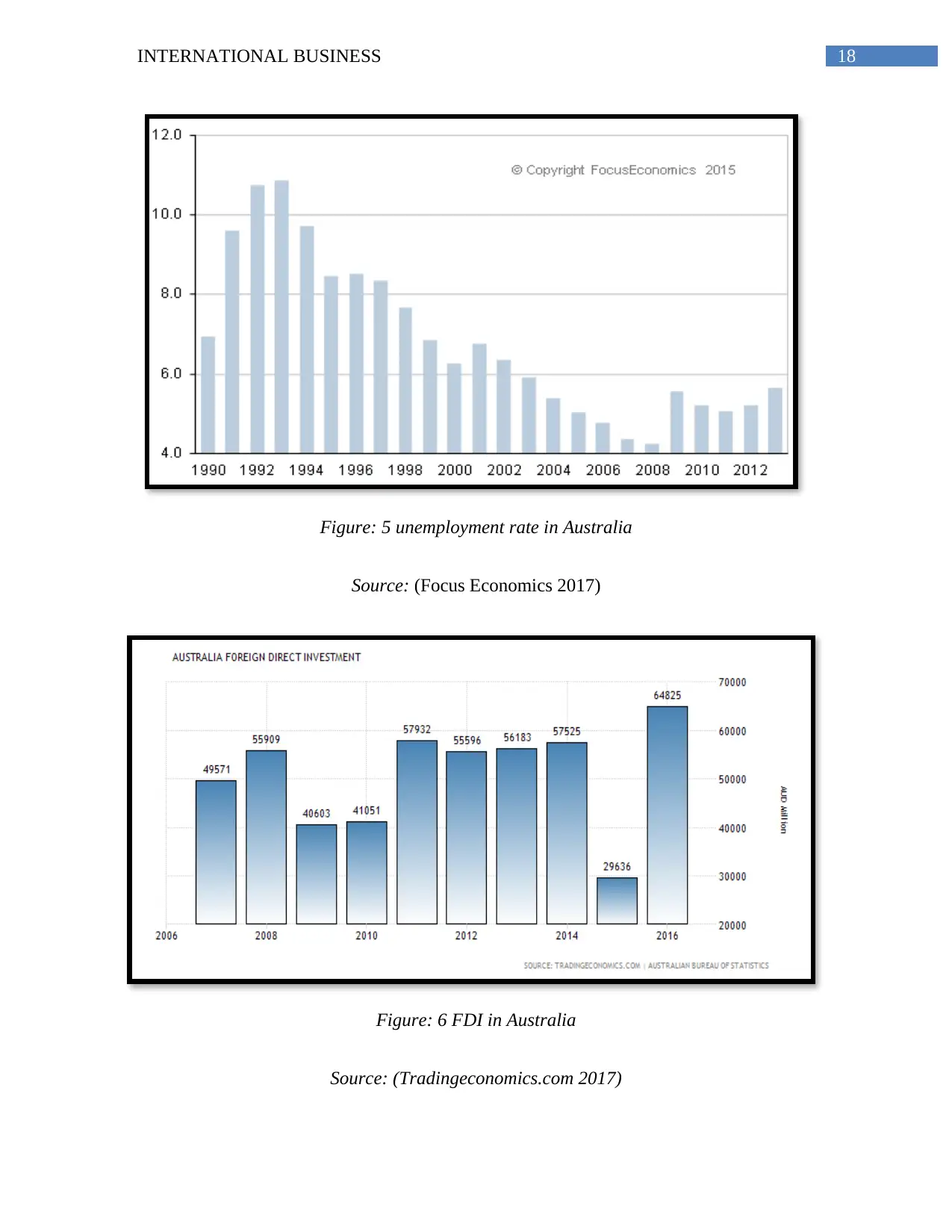
18INTERNATIONAL BUSINESS
Figure: 5 unemployment rate in Australia
Source: (Focus Economics 2017)
Figure: 6 FDI in Australia
Source: (Tradingeconomics.com 2017)
Figure: 5 unemployment rate in Australia
Source: (Focus Economics 2017)
Figure: 6 FDI in Australia
Source: (Tradingeconomics.com 2017)
Paraphrase This Document
Need a fresh take? Get an instant paraphrase of this document with our AI Paraphraser
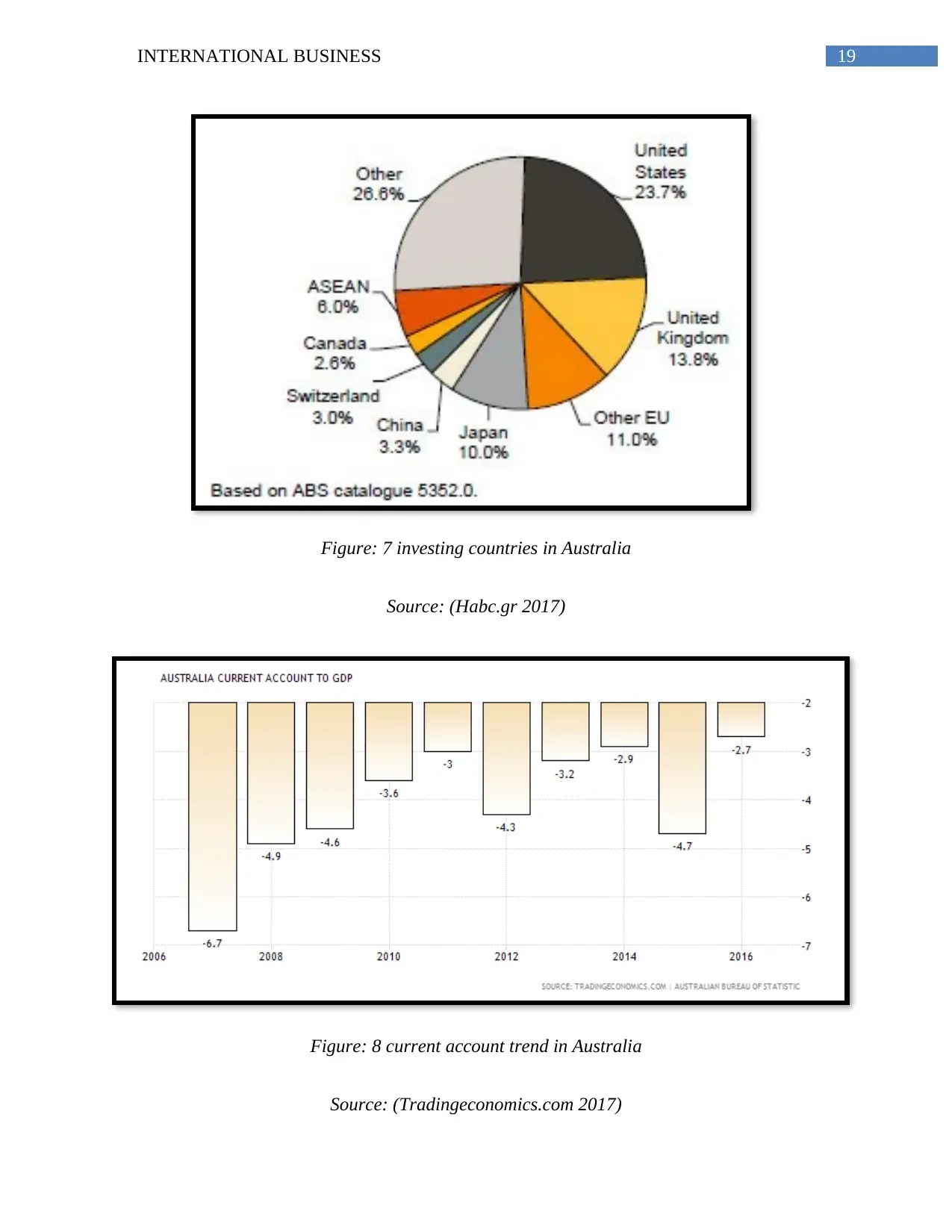
19INTERNATIONAL BUSINESS
Figure: 7 investing countries in Australia
Source: (Habc.gr 2017)
Figure: 8 current account trend in Australia
Source: (Tradingeconomics.com 2017)
Figure: 7 investing countries in Australia
Source: (Habc.gr 2017)
Figure: 8 current account trend in Australia
Source: (Tradingeconomics.com 2017)
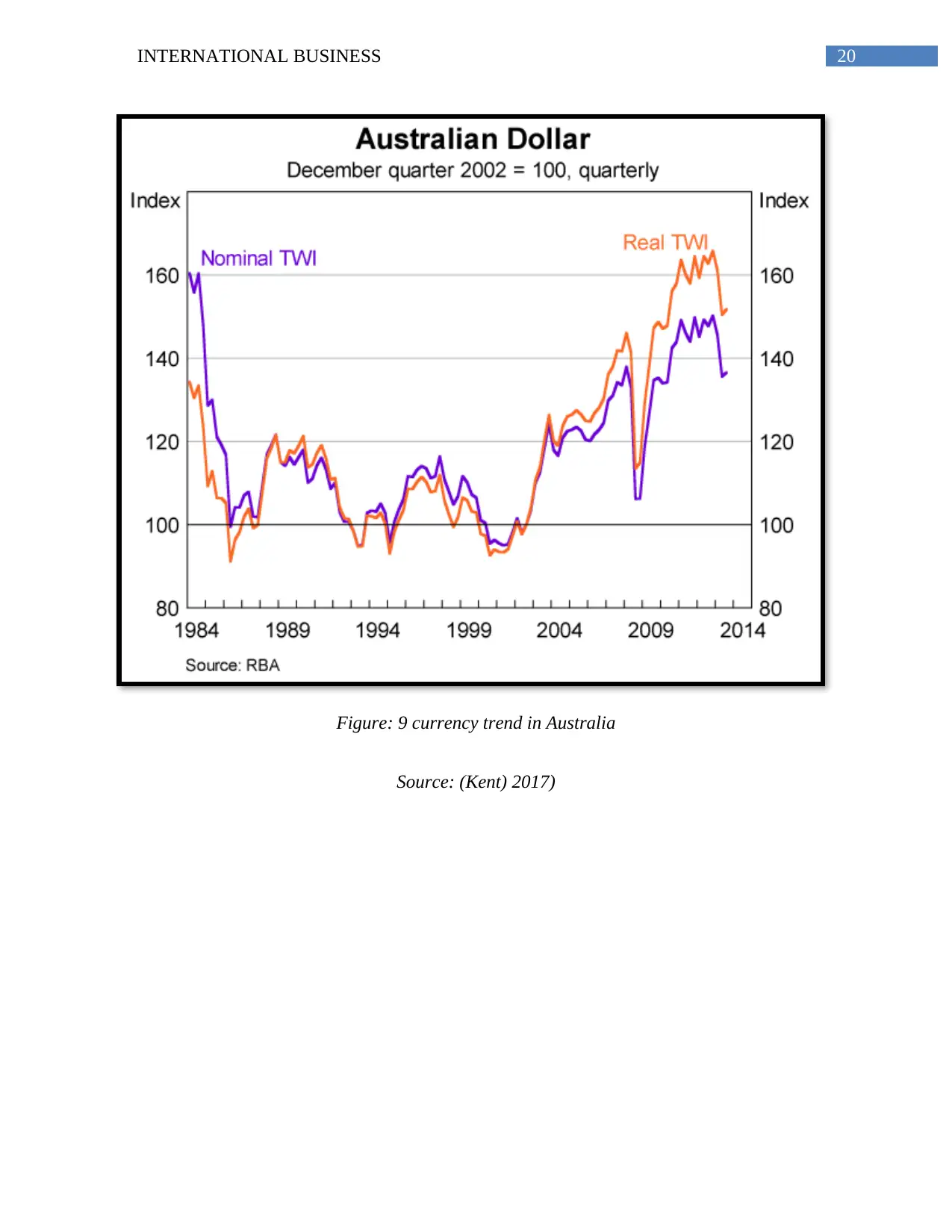
20INTERNATIONAL BUSINESS
Figure: 9 currency trend in Australia
Source: (Kent) 2017)
Figure: 9 currency trend in Australia
Source: (Kent) 2017)
1 out of 21
Related Documents
Your All-in-One AI-Powered Toolkit for Academic Success.
+13062052269
info@desklib.com
Available 24*7 on WhatsApp / Email
![[object Object]](/_next/static/media/star-bottom.7253800d.svg)
Unlock your academic potential
© 2024 | Zucol Services PVT LTD | All rights reserved.





